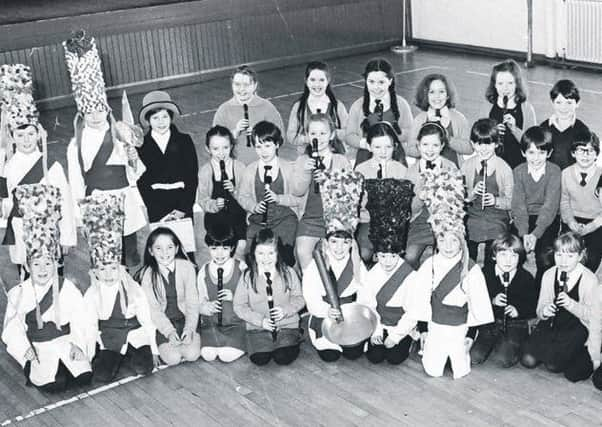Christmas customs of yesteryear as told by schoolchildren of the 1930s


The Irish Folklore Commission, under the direction of Séamus Ó Duilearga and Séan Ó Súilleabháin, collected approximately 740,000 pages (288,000 pages in the pupils’ original exercise books) of folklore and local traditions. The pages were compiled from stories written by pupils from 5,000 primary schools across the Republic between 1937 and 1939.
The children recorded their material from their parents, grandparents, and neighbours.
Advertisement
Hide AdAdvertisement
Hide AdThe scheme became known as: ‘Bailiúchán na Scol’ or ‘The Schools’ Collection.’
There are 1,128 volumes in the Collection. A title page prefaces material from each school, giving the name of the school, the parish, the barony, the county and the teacher.
The Schools’ Collection forms part of the National Folklore Collection, and is located in University College Dublin. The aim of the collection is to preserve and disseminate the oral tradition of Ireland.
In 2013, a process of digitalising the collection began, and is still currently on-going. At present, more than 80% of the schools’ collection is now available online.
Advertisement
Hide AdAdvertisement
Hide AdTales of Christmas tradition and folklore were written by a huge number of schoolchildren from every part of Donegal. Much of the stories from their exercise books have now been transcribed.
The ‘Journal’ took a browse through the pupils’ writings to see what Christmas traditions were relevant and at the forefront of children’s minds in the 1930s.
Many of the children spoke of the Christmas tradition of lighting a candle in the window on Christmas Eve ‘to guide the feet of any stranger who may be wandering around, because they believe that often Christ comes in a stranger’s guise.’
Another child said that Christmas Eve candles were lit ‘to welcome travellers or any persons looking for shelter during the night.’
Advertisement
Hide AdAdvertisement
Hide AdChristmas rhymers or ‘mummers’ as they were known, received a lot of mentions among the children’s stories.
“A batch of boys, dressed in worn out clothing go from house to house and say their rhymes. Then they get some money and they start off to the next house. They spend their collection on a little feast which they have around Christmas time,” recorded one child.
The mummers were also said to dress up in costume and false faces, complete with props and deliver short plays or recitations in neighbouring houses.
While the tradition of mummers may have largely died out, the practice of hanging stockings for Santa to fill up with presents has endured.
Advertisement
Hide AdAdvertisement
Hide AdOther children in their writings note the tradition of holly in the home at Christmas.
“It is said that the red berries represent Our Lord’s Precious Blood and the prickly leaves the Crown of Thorns.
Sometimes an altar is erected in memory of the Christ Child. The altar is decorated with holly and ivy and on it is placed the photographs of the absent members of the family. On the sixth of January the holly is burned, the candles extinguished and the photographs stored away.”
A religious theme is evident in the customs and traditions recorded by the schoolchildren. Many wrote of a belief held by families that the Holy Family would visit homes on Christmas Eve.
Advertisement
Hide AdAdvertisement
Hide AdAs a result, the doors were left open, a fire lit and the table prepared for three.
“Before Christmas they white-wash their small cabins and everything is thoroughly cleaned, so that the Holy Family might find a warm welcome before them.”
Farm animals as well, were highlighted in the children’s musings with one noting: “The belief is still held firmly that at midnight on Christmas Eve, donkeys go down on their two knees as if in adoration, and it is said that if a person touches the cross on the donkey’s back, and wishes for something, that his wish will be granted.”
Customs around New Year and celebrations are also mentioned by the children. Many children spoke of the tradition of hosting gatherings with friends and neighbours.
Advertisement
Hide AdAdvertisement
Hide Ad“It is customary to ring out the old year and bring in the new to the thundering sound of tins of every description - tin pans, cans and basins, and the sending up of rockets.
“The inhabitants of the houses, who do not take part in the celebration, all go to the doorstep to hear the songs, and when they are coming in again, if there is a black-haired girl among them, she is sent into the house first, for it is said that she is the one who brings in the New Year’s luck.”
With over half a million pages recorded from school children nearly a century ago, the School’s Collection alone, gives a fascinating insight into the customs and beliefs of the past.
The rest of the School’s Collection as well as others that make up the National Folklore Collection (NFC), can be viewed online at www.duchas.ie** Picture shows pupils from Nazareth House Primary School keeping the tradition of the Christmas mummers alive back in 1985. The custom features heavily in the tales collected in the 1930s.